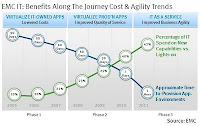First, show me the money
But where does that leave us regarding exactly what we achieved? What metrics illustrate the real benefits of all this work? Well, it turns out that EMC IT has been documenting their process since about 2005. While not all data points are completely audited, they tell a powerful story.
In the conceptual 3-phase "Journey to Your Cloud" we speak about the trend toward increased virtualization - and how it's applied. In Phase I, IT virtualizes "internal" IT-owned apps saving primarily on cost. In Phase II, IT virtualizes production applications, benefiting primarily quality-of-service and availability. And in Phase III, IT is operated as a service, primarily improving overall business agility.
But along a pragmatic journey, the benefits occur gradually, sometimes in parallel.
 EMC's IT group has been virtualizing its infrastructure - and documenting the results - since 2005. At right, the chart depicts how virtualization toward a cloud infrastructure undeniably results in improved infrastructure economics AND improved IT agility. And their trend continues.
EMC's IT group has been virtualizing its infrastructure - and documenting the results - since 2005. At right, the chart depicts how virtualization toward a cloud infrastructure undeniably results in improved infrastructure economics AND improved IT agility. And their trend continues. The other benefit from virtualization is the ability to re-construct an environment should failure occur. This impact on quality of service is available anywhere virtualization is present - so you'd expect the pervasiveness of Highly-Available environments to roughly track the degree to which virtualization is implemented.
Sure enough, as EMC virtualizes its entire infrastructure (and we're not entirely there yet) we're pushing nearly 97% of applications with High Availability.
Finally, as IT infrastructure is virtualized and consolidated, utilization rises, and (presumably) physical data center space required (not to mention power) is reduced.The EMC IT group's statistics clearly show this trend as well.
 In fact, EMC's recently-christened data center is not larger than our existing data center (as it was mainly developed to economize on power cost, and to create a physically-distanced site from EMC's HQ) so there is still lots of room to grow.
In fact, EMC's recently-christened data center is not larger than our existing data center (as it was mainly developed to economize on power cost, and to create a physically-distanced site from EMC's HQ) so there is still lots of room to grow.In the coming months, EMC, our IT department, and our consulting arm, will be continually elaborating on our own journey through transforming our IT... not just the technology, but the organizational models, operational models, consumption models, and more.
I personally have to say that the degree of rigor that Sanjay & team have put into this transformation is impressive. They have a very clear vision of where they want to be with respect to enabling the EMC business, as well as setting a clear example of what is possible for EMC customers.
Other References





